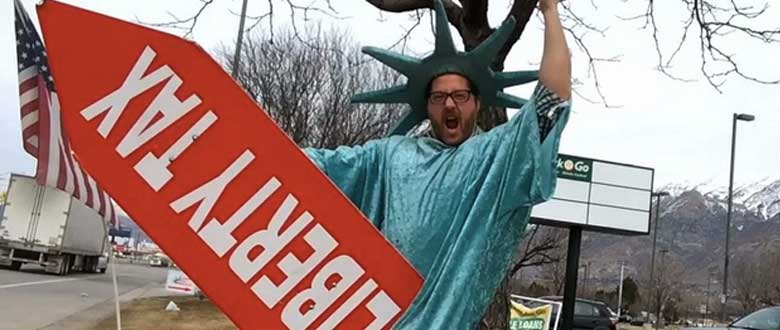The other day I saw a young man in blue jeans and a worn out polo shirt walking down the street holding up a small sign for a local business. The sign had a advertising message about what the business had to offer. I knew from experience that the business owner probably thought they were doing some affordable advertising, but what were they really accomplishing?
You’ve probably seen similar efforts to drum up business on a budget. Quick oil change centers seem to do this kind of advertising often. You see some mechanics standing on the curb waiving to passers by. Sometimes they’ll even have a sign with the current offer. During tax time I saw some people dressed up like the Statue of Liberty waiving signs offering a gift card if you came in and let them prepare your taxes.
This attempt at low cost advertising probably does more to harm the image of the business than good. And what the business owner thought was low cost advertising is probably the most expensive advertising they could possible do.
The universal method to compare the relative cost of different media is the Cost Per Thousand consumers reached. Reach is defined as the number of different people who see or hear the advertising message.
The formula for calculating Cost Per Thousand is to divide the cost of the advertising by the number of people reached multiplied by 1,000.
Just because the only cost involved was the employee’s hourly wage doesn’t mean the advertising was low cost compared to other more effective means of reaching the potential customer. In fact, just the opposite occurs since the reach of this meager advertising effort is so, well meager.
Lets work through a recent example I witnessed while out making sales calls. The manager or a local restaurant was walking door-to-door handing out menus and a coupon for a free piece of pie with a meal. Lets say the store manager makes $15 an hour and they can see 12 business in one hour assuming they spend five minutes in each store telling their story.
The cost of the advertising is $15 divided by 12 impressions which equals 1.25. Using the standard formula for calculating the Cost Per Thousand, you now multiply 1.25 by 1,000. The cost per thousand for this form of advertising is $1,250 per 1,000 people reached. At least this advertising effort involved a one-on-one personal invitation to come dine at the restaurant, but it is still a very expensive proposition.
Lets examine the example of the person dressed up as a Statue of Liberty standing on a street corner with a sign for a tax preparation company. This is a real high skilled position so lets assume they employee is making a minimum wage of say, $8 an hour. In my town I estimate that approximately 500 cars pass this intersection during an hour long period.
Eight dollars divided by 500 cars equals 0.016. Multiply that by 1,000 and the Cost Per Thousand is $16 per one thousand customers. While that may appear to be an affordable Cost Per Thousand, consider the quality of the message and the impact with a potential new client. First of all the exposure is clouded by the humor and surprise to see a Statue of Liberty holding a sign for a tax preparation service. Most of the first impression is wasted on the novelty of the situation and not on the message delivered. Remember what Will Rogers once said, “you never get a second chance to make a good first impression”. This type of advertising probably won’t reach tax payers with a complicated high margin tax return but rather the low margin, basic filer for $39 a return.
Direct Mail is one of the most expensive of the traditional media choices. A thousand stamps is $440 dollars so the math is easy to calculate even before you pay for the letter head and envelopes.
Newspaper, broadcast television and cable all have high Cost Per Thousand consumers reached because of declining audience size and high costs.
Radio continues to offer one of the lowest Cost Per Thousand costs of all major media. But the most important component of a Radio campaign is the personal nature of the way the message is delivered.
Nine out of ten consumers listen to the Radio every week. According to the Radio Advertising Effectiveness Labratory, Radio listeners feel as if Radio advertisers are trying to reach out to them on a personal level. People are emotional beings, they make decisions based on emotions. Radio is an emotional medium. People say they “love” the music a Radio station plays or the Radio station has their “favorite” personalities. They use terms of endearment to describe the way they listen to the Radio.
Here are some important questions to ask the people who are trying to sell you advertising;
What is the reach of your advertising campaign, not the reach of the medium you will be using. The two may be very different.
What is the cost per thousand reached, or even better yet, what is the cost per thousand effective reach. That is the number of people who will hear or see your advertising message a minimum of three times, not an average of three times. An average means some people may only be exposed to your message just one time.
These are simple techniques to take the mystery out of buying advertising.






